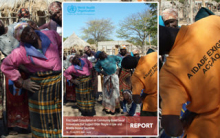Community-Based Social Innovations

Phase 1 - October 2014 to September 2015
Phase 2 - November 2016 to November 2017
Phase 1 – Multiple partners in China, India, Poland, Republic of South Africa, Thailand, Uganda and Viet Nam
Phase 2 – RAND Europe (principal implementing partner)
Phase 1 – China, India, Poland, South Africa, Thailand, Uganda, Viet Nam
Phase 2 – Chile, China, Iran (Islamic Republic of), Lebanon, Russian Federation, Serbia, Sri Lanka, Thailand, Ukraine, Viet Nam
Health systems across both developed and developing regions struggle to meet the diverse and complex needs of increasing number of older persons. We hypothesized that community based social innovations (CBSIs) can improve the health and well-being of older people through community-based care. This research therefore, endeavored to answer the following questions through case studies in 14 countries:
1) What are CBSIs?
2) Are CBSIs effective and cost-effectiveness in promoting healthy ageing?
3) What typology can help advance understanding of CBSIs at the operational level to enable
implementation?
Results
This research defined CBSIs as community initiatives that seek to: a) empower older people to improve their self-efficacy in caring for themselves and their peers; b) maintain their well-being and; c) promote social cohesion and inclusiveness.
When considering the range of ‘health’ impacts from the CBSIs, we employed the term ‘health’ very broadly – incorporating for example physical and mental health, as well as broader well-being. In terms of understanding CBSI’s effectiveness therefore, we found that:
- The main health benefits important for individuals and communities are often psycho-social, for example, the integration of socially isolated older people into mainstream community and society.
- CBSIs can lead to people-centred services through engagement and empowerment by, for example, increasing awareness and knowledge that helps older people and their families in navigating complex health and social care options. CBSIs also empower informal carers –many of whom are women.
Challenges to wider scale and equitable implementation exist for several reasons. Many CBSIs rely on volunteers or older people themselves as agents of change. Linkages to immediate health and social care systems are often limited. In addition, strategic planning remains a weakness as does the reliability and availability of long-term funding.
The great diversity of models and lack of robust monitoring and evaluation frameworks impeded evaluation of cost-effectiveness. The CBSIs studied varied widely in terms of aims, scope, setting, activities, governance and funding. Nevertheless, CBSIs could be categorised by level of empowerment, linkages to the health and social care system, and their scale, scope and complexity. Using these categories, we identified four ‘types’ of CBSI, each with strengths and challenges:
Way forward
In many cases, CBSIs begin as community initiatives that fill gaps in services that the community needs. However, such models may not be sustainable, because they are too dependent on voluntary commitment. Formal linkages with the health sector are essential, requiring a recognition of the needs of older people in national and regional policies. Future research will emphasize innovations in community-based service delivery, with an aim to assess generalizability, validity, replicability and scale-up potential.
Related PDF downloads:
- Document
- Document
- Document
- Document
- Document
- Document

